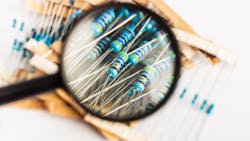This article appeared in Supply Chain Connect and has been published here with permission.
This article is part of the TechXchange: Chip Shortages and Counterfeits.
Last year, nearly $3 trillion worth of counterfeit goods traded hands—up from $30 billion in the 1980s. This makes counterfeiting at least the tenth largest economy—just above Canada's total GDP and possibly the fourth largest above Germany, according to Forbes. Responsible for 2.5 million lost jobs globally, counterfeiting has a disproportionately high impact on businesses and consumers in the U.S., where shoppers tend to purchase the highest share of counterfeit goods at around 60% to 80% of all goods sold.
Electronics counterfeiting is especially nefarious, and in some cases downright dangerous. For example, a fake part or component increases failures of systems related to performance, safety and lifecycle. “Counterfeit parts are often of poor quality and may function differently than intended. When they work differently than intended, there’s lost productivity, as counterfeit parts can lead to equipment failure,” MacroFab points out. “Failure often increases user safety risks, lawsuits, fines and brand damage.”
5 Ways to Spot a Fake
Identifying and avoiding counterfeit electronic parts and components isn’t always easy, but there are some steps that procurement professionals can take to help keep fakes out of their companies’ supply chains. Here are five red flags that electronics buyers and other professionals should watch out for when researching, selecting and ordering products:
1. An unknown supplier, manufacturer or marketplace that’s eager to do business with you. The internet is a hotbed for product sellers, not all of which are authorized, reliable or reputable. “The market, especially online, can be a daunting place where we may not always know who to trust,” IPKey cautions. “So buying from a reputable supplier can to some extent protect us from fake products.” Similarly, watch out for unusually low prices or a deal that looks like it’s too good to be true; it probably is.
2. Product pictures that don’t match their descriptions, specs or reviews. Products may be counterfeit when the pictures initially shown by the seller look different from the customer photos or other photos of the product. “Sellers making counterfeit luxury products, for example, will often remove the counterfeit logos from their images in order to avoid detection from the brand or authorities, but the customer photos or descriptions may show the product featuring the genuine brand’s logo on the fake products,” Michigan State University warns. Electronics may use a similar, “sloppy” approach to matching product photos with descriptions and specs—none of which align. Keep an eye out for these issues when shopping around.
3. Unusual shipping and packaging information. Counterfeit products, particularly those involved in drop shipping schemes, typically take much longer to ship than reputable retailers, MSU points out. “They may also advertise shipping in “discreet packaging” or large products in multiple parts. Checking the shipping times and policies can help you look at this information and determine if it seems unusual or illegitimate.”
4. The parts don’t pass the “visual” test. When visually inspecting a part for legitimacy, use a reliable microscope for a detailed view. Look for inconsistencies across the lot, such as incomplete or improper logos, incorrect manufacturing plant codes, any additional or extra markings, dull component leads, material variants and even packaging discrepancies. “[These] simple steps can work to ensure your components are legitimate,” American Computer Development states.
5. And they don’t pass the X-ray test. According to Broadline Components, the component examination is one of the most specific methods of detecting counterfeit electronic components. The inspection involves the use of a regular X-ray to view the internal parts of the product. It helps you identify anomalies such as:
- Inconsistent thickness and rough edges: As a way of eliminating the original code, the counterfeit electronic components manufacturers try to sand parts, which result in thinner parts and rough edges.
- Lack of uniformity on the indenting: To make part replacement easy, OEMs leave clear indents on the component. “In counterfeit electronic components, you may note that the indents look shallow and rough,” Broadline points out.
- Inconsistency in pins distance: The distance between the pins may be tampered with in fake components. “You may also note that the pins have oxidation or look a little too shiny,” the company adds.
Read more articles in the TechXchange: Chip Shortages and Counterfeits.
About the Author
Tyler Fussner
Managing Editor - Community Manager | Supply Chain Connect
Tyler Fussner is Managing Editor - Community Manager at Supply Chain Connect, part of the Design & Engineering Group at Endeavor Business Media.
Previously, Fussner served as the Associate Editor for Fleet Maintenance magazine. As part of Endeavor's Commercial Vehicle Group, his work has been published in FleetOwner magazine, as well as Bulk Transporter, Refrigerated Transporter, and Trailer-Body Builders.
Fussner's May 2022 print feature 'The dawn of hydrogen trucks' was named the best single technology article in B2B by the judges of the 2022 Folio: Eddie and Ozzie Awards. Fussner was also awarded Silver in the Technical Article category for the Trade Association Business Publications International (TABPI) 2021 Tabbie Awards.
Fussner previously served as Assistant Editor for Endeavor's Transportation Group on the PTEN, Professional Distributor, and VehicleServicePros.com brands.
Fussner studied professional writing and publishing at the University of Wisconsin-Whitewater. He has experience in shop operations, is a Michelin Certified Tire Technician, and a Michelin Certified Tire Salesperson.

